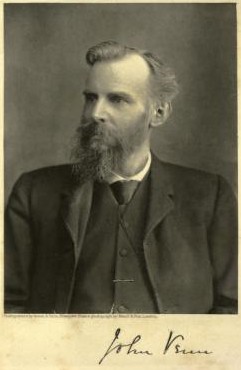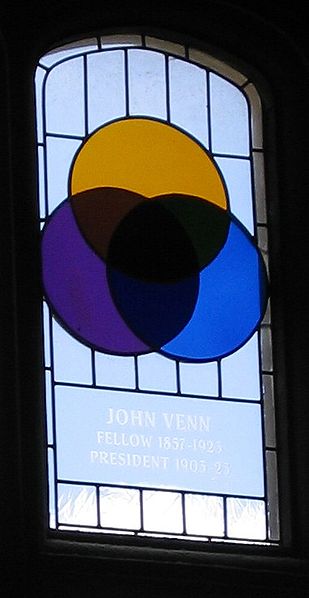<Back to Index>
- Mathematician and Philosopher John Venn, 1834
- Author Knut Hamsun, 1859
- Governor of Indiana Oliver Hazard Perry Throck Morton, 1823
PAGE SPONSOR


John Venn FRS (4 August 1834 – 4 April 1923), was a British logician and philosopher. He is famous for introducing the Venn diagram, which is used in many fields, including set theory, probability, logic, statistics, and computer science.
John Venn was born in 1834 at Hull, Yorkshire. His mother, Martha Sykes, came from Swanland, near Hull, and died while John was only three. His father was the Rev. Henry Venn who, at the time of John's birth, was the rector of the parish of Drypool near Hull. Henry Venn, a fellow of Queens', was from a family of distinction. His own father, John's grandfather, was the Rev. John Venn who had been the rector of Clapham in south London. He was a leader of the Clapham Sect, a group of evangelical Christians centered on his church who campaigned for prison reform and the abolition of slavery and cruel sports. His son described him thus: "Of spare build, he was throughout his life a fine walker and mountain climber, a keen botanist, and an excellent talker and linguist. John Venn's father (Henry) also played a prominent role in the evangelical Christian movement. The Society for Missions in Africa and the East was founded by evangelical clergy of the Church of England in 1799, and in 1812 it was renamed the Church Missionary Society for Africa and the East. Henry Venn was secretary to this Society from 1841. He moved to Highgate near London in order to carry out his duties and held this position until his death in 1873.
John Venn was brought up strictly. It was expected that he would follow the family tradition into the Christian ministry. After Highgate School, he entered Gonville and Caius College, Cambridge, in 1853. He was graduated in 1857 and shortly afterward was elected a fellow of the college. He was ordained as a deacon at Ely in 1858 and became a priest in 1859. In 1862 he returned to Cambridge as a lecturer in moral sciences.
Venn also had a rare skill in building machines. He used his skill to build a machine for bowling cricket balls, which was so good that when the Australian Cricket team visited Cambridge in 1909, Venn's machine clean bowled one of its top stars four times.
Venn's main area of interest was logic and he published three texts on the subject. He wrote The Logic of Chance which introduced the frequency interpretation or frequency theory of probability in 1866, Symbolic Logic which introduced the Venn diagrams in 1881, and The Principles of Empirical Logic in 1889.
In 1883, Venn was elected to the Royal Society. In 1897, he wrote a history of his college, called The Biographical History of Gonville and Caius College, 1349 – 1897. He began a compilation of biographical notes of Cambridge University alumni, a work which was continued by his son, John Archibald Venn (1883 - 1958) and published as Alumni Cantabrigienses in 10 volumes from 1922 - 1953.
John Venn died in 1923 at Cambridge, and was buried nearby at Trumpington Churchyard (Extension).
In 1867 Venn married Susanna Carnegie Edmonstone, the daughter of the Rev Charles Edmonstone. They had one child, a son John Archibald Venn, who in 1932 became president of Queens' College, Cambridge. Venns father and son wrote Alumni Cantabrigienses together.
The annals of a clerical family (1904) traces the Venn family history back to the seventeenth century - he was the eighth generation of his family to have a university education. In 1910 he published a work on historical biography, namely a treatise on John Caius, one of the founders of his College. Three years later he published Early Collegiate Life which collected many of his writings describing what life was like in the early days of Cambridge University. Working with his son he then started the immense task of compiling a history of Cambridge University Alumni Cantabrigienses. The first volume, published in 1922, contained 76,000 names and covered the period up to 1751. It was:
"...
nothing less than a "biographical list of all known students,
graduates, and holders of office at the University of Cambridge from
the earliest times to 1900". ... The Venns, father and son, spared no
industry in building up these records, which are of extraordinary value
to historians and genealogists ...
A stained glass window in the dining hall of Gonville and Caius College, Cambridge, commemorates Venn's work. Venn is commemorated at the University of Hull by the Venn Building, built in 1928.